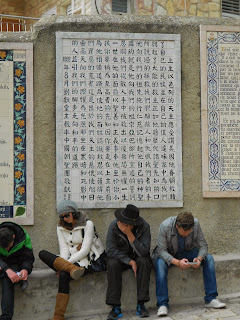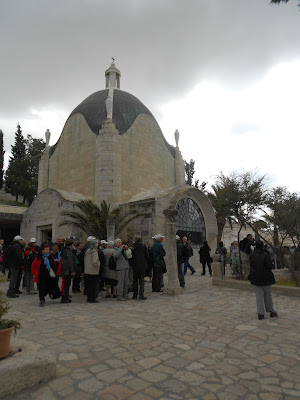 |
| Mardin from the approach road |
The last full day of our pilgrimage is spent in
Mardin with its many churches and much history:
First we visit the museum in
Mardin, housed in what used to be the
Syrian Catholic Patriarchate. The building was purchased by the Ministry of Culture who restored it and opened it as a museum in 2000. It reflects a typical Mardin house, on three floors with a U-shaped floor plan and facing South to the Mesopotamian Plain, It is small but has some fascinating artifacts, ranging from Assyrian to Ottoman times, reflecting some of the extraordinary history of this part of the world.
I feel we have too little time here, although not everyone agrees!
There are children playing in the ArkeoPark, an enclosure within the museum grounds, where they are being taught the principles of archaeology and the archaeological importance of the area in which they live through the power of play. They seem to be having a great deal of fun.
 |
| symbols of nature on a tomb stone |
There is then just a short walk to the
Kirklar Kilisesi, the
Syrian Orthodox Church of the
Forty Martyrs, originally dedicated in 569 to
Mor Behnam and Saro, which is found up a side street behind the museum. After silence and prayer Father Gabriyel (Gabriel) is delighted to tell us about this lovely church and some of its history.
He asks that we take no photos within the church, which is a shame as there are also no postcards to bring home to remind us of its beauty. I wonder why he takes this stance – perhaps it is for reasons of security?
 |
| Church of the forty martyrs |
This fourth and fifth century building is the central church for Christian worship in
Mardin. There are something like 80 Christian families across four (or was it five) different Christian churches in the town, representing
Syrian Protestant, Armenian Catholic, Syrian Orthodox and
Chaldean Catholic (
Mardin was a diocese of the
Chaldean Church from the sixteenth century to 1941 at which time the diocese ceased to exist). Father Gabriyel celebrates the
Syrian Orthodox liturgy in them all in turn.
 |
| Picture of the 40 martyrs in the Chaldean Church |
We hear from Father Gabriyel that the government is beginning to allow the teaching of Aramaic again, and that this church is also visited by many interested Muslims, which gives Father Gabriyel the chance to explain the full history and the importance of Christianity to this area. There are some lovely and interesting features in the church. Unusually for churches in this area, there are doors that open and close across the sanctuary, in addition to the usual painted cloth or
sutoro that can be pulled across during the liturgy. There are also five ancient wooden altars in the church, although the high altar itself seems to be made of what look to me like concrete breeze blocks and I mean no offence by saying this. It simply reflects what I saw. Over the sanctuary in front of the altar hangs the traditional dove, pointing to heaven.
 |
| the Chaldean Catholic Church |
As we are told the stories of the
forty martyrs, to whom the church is dedicated, and the
seven sleepers of Ephesus, we can hear clearly the mid morning muezzin call to prayer from the surrounding minarets, a reminder if one was needed that Christians are in a very small minority here in this secular state but very Muslim country.
We admire the very old printing press. We had seen something similar at a previous monastery, where the monk dreams one day of building it together again into full working order.
Afterwards cay is served to us all in the former Patriarchal Residence in
Mardin. I ask about postcards. Many of us, I say, would love to buy some. Instead we are given a plentiful supply of glossy illustrated leaflets, sadly not in English, but they are useful souvenirs for all that.
 |
| view over the Mesopotamian Plain from the restaurant |
Then it is just a short walk east along the main street to the
Chaldean Catholic Church of
Mor Hűrműzd – brilliant colors and certainly very different from the Orthodox style we have become accustomed to.
Lunch is in a great restaurant,
Cercis Murat Konagi on the main street. The setting is authentic, a true mansion owned by an old
Mardin family, the food excellent and the views over the
Mesopotamian plain stunning. Then it is time to explore a little up into the old part of town. The narrow streets seem like a maze and it would be futile to try to follow any map. However any route upwards or downwards as appropriate will bring one back before too long to the main road running east/west through the middle of the town.

Donkeys are a common site, used to transport goods along these narrow streets.
 |
| a soap shop in Mardin |
We have time for some gift shopping in the bazaar and along the main street,
 |
| sunset at the monastery |
and finish with cay and baklavas in a pastry shop and café near the museum,
 and finally it’s back to the monastery to admire a fabulous sunset before going inside for evening prayer.
and finally it’s back to the monastery to admire a fabulous sunset before going inside for evening prayer.






















































